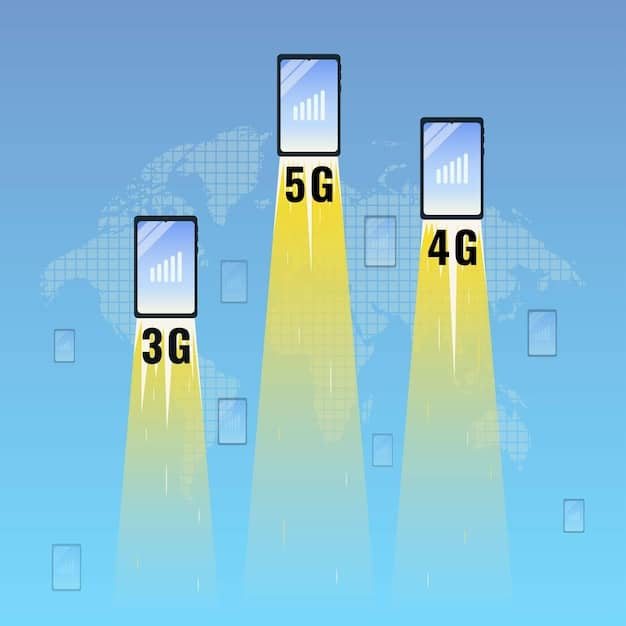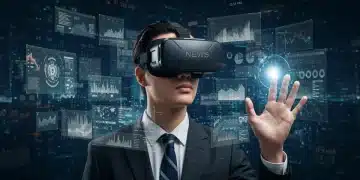5G Home Internet & The Metaverse: A Deep Dive for US Consumers

Is Your 5G Home Internet Ready for the Metaverse? A Consumer Tech Deep Dive explores whether current 5G home internet technology in the US is robust enough to meet the high-bandwidth, low-latency demands of immersive metaverse experiences.
The metaverse promises to revolutionize how we interact, work, and play, but can your 5G home internet connection handle it? This article delves into the technical requirements of the metaverse and assesses whether current 5G home internet offerings in the US are up to the task, providing valuable insights for tech-savvy consumers.
Understanding the Metaverse and Its Demands
The metaverse, a nascent yet rapidly evolving concept, envisions a persistent, shared, 3D virtual world accessible through various devices. But what exactly does it demand from our internet connections?
The metaverse isn’t just about playing simple online games. It’s about immersive experiences, real-time interactions, and massive amounts of data transfer. This puts significant strain on your home internet.
Bandwidth Requirements
High-resolution graphics, real-time streaming, and complex interactions all require substantial bandwidth. The metaverse will need consistent and fast upload and download speeds.
Latency Sensitivity
Low latency, or minimal delay in data transfer, is critical. High latency can lead to lag, motion sickness, and a generally poor user experience. Real-time interactions demand extremely low latency.

Processing Power
While cloud computing will handle some of the processing, local devices (VR headsets, AR glasses) still need significant processing power. A robust home network ensures smooth communication.
- Sufficient bandwidth is crucial for high-quality visuals and data transfer.
- Low latency is essential for real-time interactions and preventing motion sickness.
- Reliable connectivity ensures seamless transitions between virtual and physical worlds.
In conclusion, the metaverse places immense demands on internet connectivity, requiring high bandwidth, low latency, and reliable connections to deliver a truly immersive and seamless experience.
5G Home Internet: A Potential Solution?
5G home internet is emerging as a promising alternative to traditional cable or fiber connections. But how does it stack up against the metaverse’s demanding requirements?
Promising faster speeds and lower latency compared to older technologies, 5G home internet has the potential to be a game-changer for metaverse accessibility.
What is 5G Home Internet?
5G home internet uses cellular 5G technology to provide wireless internet access to your home. It bypasses the need for physical cable connections.
Theoretical Benefits
In theory, 5G offers significantly faster speeds and lower latency than 4G LTE. This could translate to better metaverse performance.
US Availability and Providers
Several major US providers, including Verizon, T-Mobile, and AT&T, offer 5G home internet plans. Availability varies depending on location.
- 5G home internet offers a wireless alternative to traditional cable connections.
- Theoretical advantages include faster speeds and lower latency.
- Availability in the US varies by provider and location.
In summary, 5G home internet presents a potential solution for meeting the metaverse’s connectivity demands, offering a wireless alternative with the promise of faster speeds and lower latency, although availability may vary.
Real-World Performance: Can 5G Deliver?
While 5G home internet holds promise, real-world performance is often different from theoretical capabilities. Let’s examine the actual speeds and latency users are experiencing.
The key question is: is the performance of 5G home internet consistent and reliable enough for the demanding applications of the metaverse?
Reported Speeds and Latency
User reports indicate that 5G home internet speeds can vary significantly based on location, network congestion, and device capabilities. Latency can also fluctuate.
Factors Affecting Performance
Distance from the cell tower, signal interference, and the number of users on the network can all impact performance. Weather conditions can also play a role.
Comparison to Other Internet Types
Compared to fiber, 5G home internet may still lag in terms of consistent speed and latency. Cable internet often provides more reliability.

- Real-world speeds and latency of 5G home internet can vary significantly.
- Performance is affected by factors such as location and network congestion.
- Fiber internet generally offers superior performance and reliability.
To conclude, while 5G home internet shows potential, its real-world performance in terms of speed and latency can vary, potentially impacting its suitability for demanding metaverse applications.
Optimizing Your 5G Home Internet for the Metaverse
Even if your 5G home internet isn’t perfect, there are steps you can take to optimize it for a better metaverse experience. Let’s explore some practical strategies.
Maximizing bandwidth and minimizing latency, even with existing constraints, are key to enjoying a smoother metaverse experience.
Placement of Your Router/Modem
Position your 5G router in a central, elevated location with minimal obstructions. Avoid placing it near walls or metal objects.
Reducing Network Congestion
Limit the number of devices using your internet connection simultaneously. Close unnecessary applications and background processes.
Using a Wi-Fi Extender
If you have a large home, a Wi-Fi extender can help improve signal strength and coverage throughout your house. Consider a mesh Wi-Fi system for even better performance.
- Optimize router placement to maximize signal strength and minimize interference.
- Reduce network congestion by limiting the number of connected devices.
- Consider using a Wi-Fi extender or mesh system for better coverage.
In conclusion, optimizing your 5G home internet setup by strategically placing your router, minimizing network congestion, and improving Wi-Fi coverage can enhance your metaverse experience.
Future of 5G and the Metaverse
The future of 5G technology and its impact on the metaverse is promising. Ongoing advancements are expected to address current limitations and unlock new possibilities.
As 5G technology matures, it is poised to play an increasingly significant role in enabling immersive and seamless metaverse experiences.
Advancements in 5G Technology
Ongoing research and development are focused on improving 5G speeds, latency, and reliability. New technologies like millimeter wave and network slicing are being implemented.
The Role of Edge Computing
Edge computing, brings processing closer to the user. This can significantly reduce latency and improve the responsiveness of metaverse applications.
Potential Synergies
The combination of improved 5G and edge computing will enable more realistic and immersive metaverse experiences. Think of real-time collaboration, virtual tourism, and advanced gaming.
- Ongoing advancements in 5G technology are expected to improve speed and latency.
- Edge computing will bring processing closer to the user, reducing latency.
- Synergies between 5G and edge computing will unlock new metaverse possibilities.
In summary, the future of 5G and its impact on the metaverse are promising, with ongoing advancements expected to address current limitations and unlock new immersive experiences through technologies like edge computing.
Making the Right Choice for Your Metaverse Needs
Choosing the right internet connection for the metaverse depends on your individual needs, budget, and location. Consider these factors when making your decision.
Careful consideration of bandwidth, latency, and reliability is essential when selecting an internet plan for optimal metaverse performance.
Assessing Your Bandwidth Needs
Consider the types of metaverse experiences you plan to engage in. High-resolution gaming and streaming require more bandwidth than simple social interactions.
Evaluating Latency Requirements
If you plan to participate in real-time interactions, prioritize low latency. Gamers and professionals who require low latency should be especially vigilant.
Considering Alternatives
Explore all available internet options in your area, including fiber, cable, and fixed wireless. Compare pricing, speeds, and reliability.
- Assess your bandwidth needs based on planned metaverse activities.
- Evaluate latency requirements, especially for real-time interactions.
- Compare all available internet options in your area.
In conclusion, choosing the right internet connection for the metaverse involves assessing your specific needs, evaluating latency requirements, and comparing all available options to make an informed decision that optimizes performance.
| Key Aspect | Brief Description |
|---|---|
| 🌐 Metaverse Demands | High bandwidth, low latency, and stable connections are vital. |
| 📶 5G Potential | Offers faster speeds and lower latency compared to older networks. |
| 🚦 Real-World Issues | Performance varies due to location, congestion, and interference. |
| 🚀 Future Growth | Advancements and edge computing will boost metaverse experiences. |
Frequently Asked Questions
▼
Availability varies. Check with Verizon, T-Mobile, or AT&T to see if it’s offered in your area. Coverage is expanding, but may not yet be universal.
▼
Speeds range widely, from 50 Mbps to 300 Mbps or more, but actual performance can vary. Adequate speed is vital for seamless experiences in the metaverse.
▼
High latency causes lag, disrupting real-time interactions. Lower latency is crucial for a smooth, immersive metaverse experience reducing discomfort and enhancing realism.
▼
Yes, by placing your router strategically, reducing network congestion, and using Wi-Fi extenders, you can boost performance. Consider upgrading hardware, too.
▼
It depends on your needs, availability, and budget. Fiber is often superior, but 5G can be viable. Evaluate all options before deciding that 5G is the right choice.
Conclusion
While 5G home internet presents a promising avenue for metaverse accessibility, its real-world performance and suitability depend on various factors. By understanding the technology’s demands, evaluating real-world performance, and optimizing your setup, you can make informed decisions to ensure a seamless transition towards the metaverse era.





